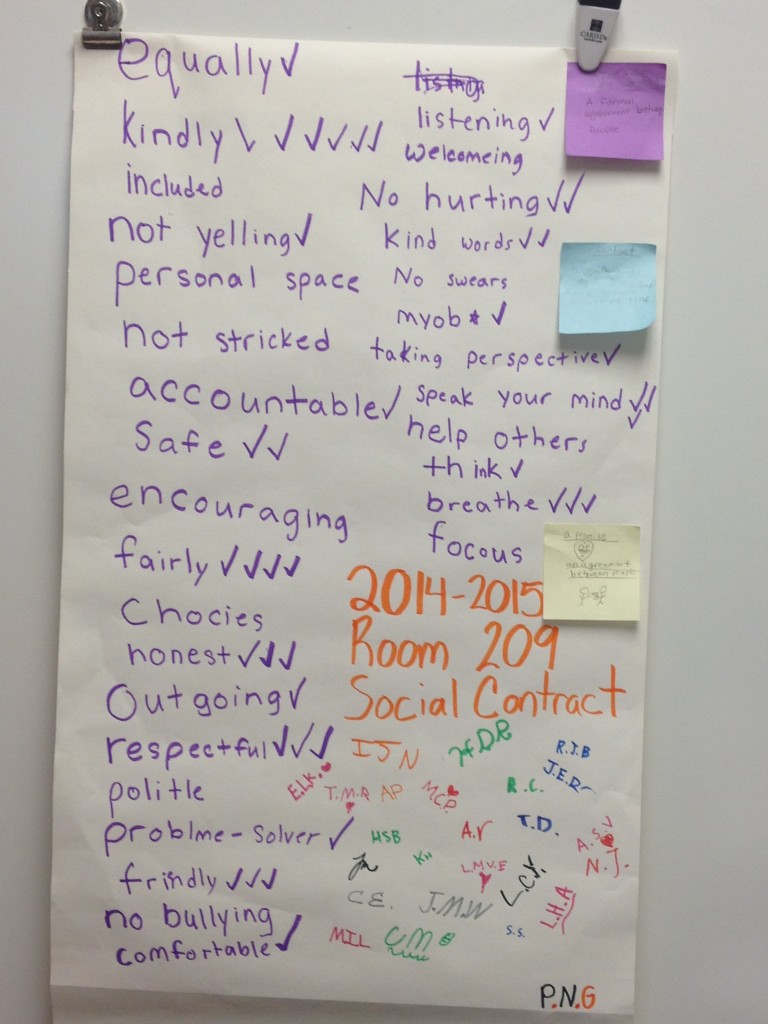Viewing: consequences
October 2, 2014
Our Social Contract (Classroom Community – Part 2)
In a recent post, I wrote about how we work to build a cohesive classroom community in our room. In this post, I will share our classroom’s social contract with you, as well as explain how we help one another to live up to the contract. In early August, I attended the Capturing Kids’  Hearts workshop (which I described in the previous post). One substantial focus of the workshop was the concept of using a social contract. This document outlines how students want to be treated by teachers, how teachers want to be treated by students, how students want to be treated by one another, and how we all want to be treated by either during a conflict. After brainstorming descriptors over the first few weeks of school, groups of students shared out their ideas, and we made a master list as a class. As descriptors were repeated, we added checks to the list. We didn’t distinguish between the four categories I listed because it became apparent (by design) that the descriptions we found were applicable in all instances.
Hearts workshop (which I described in the previous post). One substantial focus of the workshop was the concept of using a social contract. This document outlines how students want to be treated by teachers, how teachers want to be treated by students, how students want to be treated by one another, and how we all want to be treated by either during a conflict. After brainstorming descriptors over the first few weeks of school, groups of students shared out their ideas, and we made a master list as a class. As descriptors were repeated, we added checks to the list. We didn’t distinguish between the four categories I listed because it became apparent (by design) that the descriptions we found were applicable in all instances.
I must tell you how very impressed I was by the depth of thought that the kids put into their brainstorming. As you can see from our social contract, some ideas were common themes in our discussion: kindness, fairness, honesty, respect, friendliness, safety, candor, patience, and more! All students chose to sign the contract as their agreement to try to live up to the document. (This wasn’t mandatory – everyone CHOSE to get “on board” with the contract.)
One reminder that I give to the class is that we will not be perfect in following the contract. There are days when we all make mistakes, and what’s important is that we work to make the best choices we possibly can, rather than being perfect. The word “accountable” only came up twice, but I think we’ve found that it’s become one of the most important words in the contract as it’s been put to use.
When students (or I, for that matter) don’t live up to the social contract, we use the document to help us to problem solve. Rather than discussions taking the tone of “You are breaking the rules. You may not do that.” or “You’re not allowed to take things of ___’s desk.” we can instead refer back to the social contract. Conversations have a more positive tone, such as: “Billy, we all agreed to follow the social contract so that everyone can learn in a comfortable, safe environment. We agreed to treat each other kindly. You signed this contract, and we all need to work hard to be successful. When you _________, do you think it helped _______ to feel respected? … How could we help ____ to feel respected?” Notice how I use words from the contract in that example – it’s a document that the kids generated, so they have a great sense of ownership over it. They want to live up to the social contract.
The reality, of course, is that we won’t always be successful. Part of building a classroom community involves empowering students to help one another to be successful. When they see another student not making good choices, they’re encouraged to use a gesture – a wiggling fist, with the thumb extended upward – to help their peer to make a better choice. This isn’t a way of tattling on a classmate to me, indeed, I tell the kids that this works best when I have no idea that it’s happening. The best metaphor is a baseball connection. When a player is having a rough time at a game and gets in the umpire’s face to scream, his fellow players run up and often hold him back and bring him back to the dugout. Why? Because they want to keep their teammate in the game, working to help the team to win. It’s the same idea in our class – using the thumb gesture is intended to help a peer to make better choices so that they can stay “in the game” and keep our whole class successful.
When poor choices continue, we do need to rely on classroom consequences. But like the social contract, these were student-generated. We talked about the difference between punishments and consequences, and that punishments are designed to be punitive, while consequences are simply the effects that follow a choice we make. When you look at our list of consequences, you’ll see that many of the kids’ ideas were more like punishments (listed in purple) rather than consequences (yellow highlighting). I believe in logical consequences – making sure that the consequence is connected to the choices that the student made. Items in green can happen anytime, but you’ll see that students will be given a warning and then asked to take a time out before having to visit the office.
In the next post (the third and final in the series), I’ll tell you a bit about some of the ways I help students to motivate themselves to make the best choices they can! Stay tuned!
Posted in Class Updates|By Jon Moss
